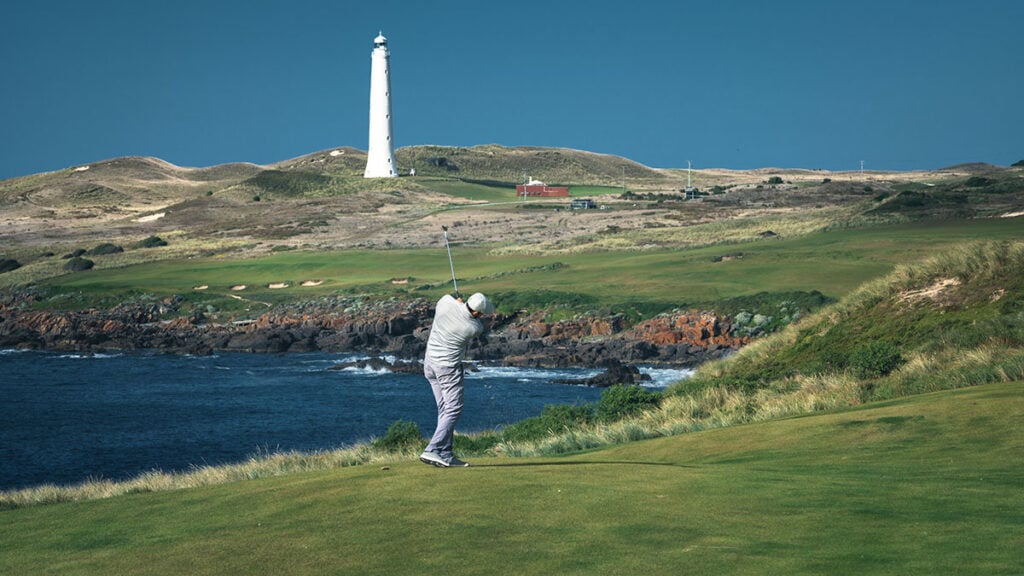Unilateral exercises, in which you isolate and train with just one limb, have become increasingly popular with golfers for a variety of reasons including injury prevention, correcting muscular imbalances and being able to train for power without putting too much stress on the spine. Golf Digest’s Certified Fitness Trainers often emphasize weight-bearing moves involving only one leg or arm to help their clients counter the “one-sided” nature of golf. “Whether it’s because of golf, playing other sports or just through your activities of daily life, you’re almost always going to find muscular imbalances in your body—one side stronger or weaker than the corresponding muscle on the other side,” says Ben Shear, Golf Digest’s chief fitness advisor and architect of our Certified Fitness Trainer curriculum.
Shear has trained several PGA Tour pros including Luke Donald, Jason Day and Webb Simpson (and currently Daniel Berger and Matthieu Pavon). “Although you see a lot of tour pros training unilaterally, it’s actually just as, if not more, beneficial for everyday golfers to train this way,” he says.
More Fitness From Golf Digest  Fitness 4 yoga-based golf exercises to prevent early extension and improve rotation
Fitness 4 yoga-based golf exercises to prevent early extension and improve rotation  Fitness Protect your shoulders and gain speed with these at-home exercises
Fitness Protect your shoulders and gain speed with these at-home exercises  Fitness 3 back-saving exercises for a more powerful swing
Fitness 3 back-saving exercises for a more powerful swing
If you’re looking for some examples of unilateral exercises that are great for golf, seven-time PGA Tour winner Billy Horschel demonstrated several in his two-part video series for Golf Digest, “Training with the Tour.” He shared his pre-round warm-up and his in-season workout during off weeks from tournament play alongside his trainer, Alex Bennett, and that included moves such as single-leg squats, bird-dog rows and single-leg “y’s.”
One particular advantage to training unilaterally is you can really tax a particular muscle without needing to move a heavy weight to do so. In many cases, just trying to perform a body-weight exercise on one leg or one arm is enough to challenge you.
Try these exercises Horschel demonstrates to help protect your knees, hips and back, balance your body and boost your performance on the golf course. When doing them, you can use a lighter weight than Horschel or no weight at all. The focus should be on proper form, so go slow.
SINGLE-LEG SQUATS
Holding a lightweight dumbell in a vertical orientation with both hands supporting the top bell, sit back toward a bench or similar using only one leg to support the move. Once your glutes touch the bench, push back up through the heel of the planted leg. If it’s too difficult to do initially, perform without a dumbbell. Remember to avoid letting the knee of the support leg jut out past the toes. Do as many reps as you can. Switch leg positions and repeat.Why this helps: Lower-body stability and strength is where all the long-ball hitters get their power. Being able to push into the ground with the lead leg in the downswing creates and stores a lot of energy that can be transferred into the club and ball though impact.
BIRD-DOG ROWS
Grab a dumbbell in one hand and plant the knee on the same side and the opposite hand on a bench for support. The other leg should be extended behind you with your back flat. While squeezing your glutes and core muscles, raise the dumbbell straight up toward the side of your torso. Keep your balance and lower to the start position. Do several reps until fatigues and then switch arm and leg positions to repeat.Why this helps: Balancing on the bench helps recruit your core muscles and promotes a more stable golf swing. Performing a row with the dumbbell improves strength in the posterior muscles of the mid and upper back, which in turn helps you power the club laterally and rotationally across your body in the downswing.
SINGLE-LEG “Y’S”
Grab a lightweight dumbbell in each hand and stand on one leg, with the other raised behind you, knee bent. Your torso should be leaning forward slightly. Raise the dumbbells up vertically to head height while keeping your arms straight. Do several reps until fatigued and then switch leg positions and repeat.Why this helps: Single-leg balancing promotes better proprioception when you swing a club, meaning you have better awareness of how footwork players a key role in a functional and controllable swing. Raising the dumbbells to create a letter “Y” helps improved strength and mobility in the shoulders and upper back, which are key to mainting width in your swing and striking the ball on the center of the face more consistently.
This article was originally published on golfdigest.com



